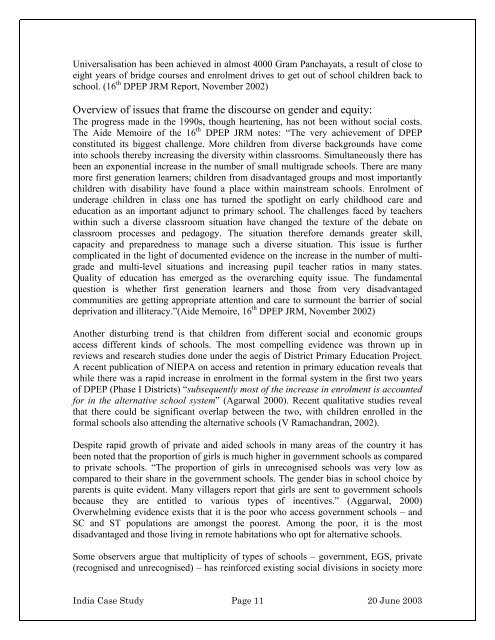Where are we today with respect to girls' education
Where are we today with respect to girls' education
Where are we today with respect to girls' education
- No tags were found...
Create successful ePaper yourself
Turn your PDF publications into a flip-book with our unique Google optimized e-Paper software.
Universalisation has been achieved in almost 4000 Gram Panchayats, a result of close <strong>to</strong>eight years of bridge courses and enrolment drives <strong>to</strong> get out of school children back <strong>to</strong>school. (16 th DPEP JRM Report, November 2002)Overview of issues that frame the discourse on gender and equity:The progress made in the 1990s, though heartening, has not been <strong>with</strong>out social costs.The Aide Memoire of the 16 th DPEP JRM notes: “The very achievement of DPEPconstituted its biggest challenge. More children from diverse backgrounds have comein<strong>to</strong> schools thereby increasing the diversity <strong>with</strong>in classrooms. Simultaneously there hasbeen an exponential increase in the number of small multigrade schools. There <strong>are</strong> manymore first generation learners; children from disadvantaged groups and most importantlychildren <strong>with</strong> disability have found a place <strong>with</strong>in mainstream schools. Enrolment ofunderage children in class one has turned the spotlight on early childhood c<strong>are</strong> and<strong>education</strong> as an important adjunct <strong>to</strong> primary school. The challenges faced by teachers<strong>with</strong>in such a diverse classroom situation have changed the texture of the debate onclassroom processes and pedagogy. The situation therefore demands greater skill,capacity and prep<strong>are</strong>dness <strong>to</strong> manage such a diverse situation. This issue is furthercomplicated in the light of documented evidence on the increase in the number of multigradeand multi-level situations and increasing pupil teacher ratios in many states.Quality of <strong>education</strong> has emerged as the overarching equity issue. The fundamentalquestion is whether first generation learners and those from very disadvantagedcommunities <strong>are</strong> getting appropriate attention and c<strong>are</strong> <strong>to</strong> surmount the barrier of socialdeprivation and illiteracy.”(Aide Memoire, 16 th DPEP JRM, November 2002)Another disturbing trend is that children from different social and economic groupsaccess different kinds of schools. The most compelling evidence was thrown up inreviews and research studies done under the aegis of District Primary Education Project.A recent publication of NIEPA on access and retention in primary <strong>education</strong> reveals thatwhile there was a rapid increase in enrolment in the formal system in the first two yearsof DPEP (Phase I Districts) “subsequently most of the increase in enrolment is accountedfor in the alternative school system” (Agarwal 2000). Recent qualitative studies revealthat there could be significant overlap bet<strong>we</strong>en the two, <strong>with</strong> children enrolled in theformal schools also attending the alternative schools (V Ramachandran, 2002).Despite rapid growth of private and aided schools in many <strong>are</strong>as of the country it hasbeen noted that the proportion of girls is much higher in government schools as comp<strong>are</strong>d<strong>to</strong> private schools. “The proportion of girls in unrecognised schools was very low ascomp<strong>are</strong>d <strong>to</strong> their sh<strong>are</strong> in the government schools. The gender bias in school choice byp<strong>are</strong>nts is quite evident. Many villagers report that girls <strong>are</strong> sent <strong>to</strong> government schoolsbecause they <strong>are</strong> entitled <strong>to</strong> various types of incentives.” (Aggarwal, 2000)Overwhelming evidence exists that it is the poor who access government schools – andSC and ST populations <strong>are</strong> amongst the poorest. Among the poor, it is the mostdisadvantaged and those living in remote habitations who opt for alternative schools.Some observers argue that multiplicity of types of schools – government, EGS, private(recognised and unrecognised) – has reinforced existing social divisions in society moreIndia Case Study Page 11 20 June 2003












